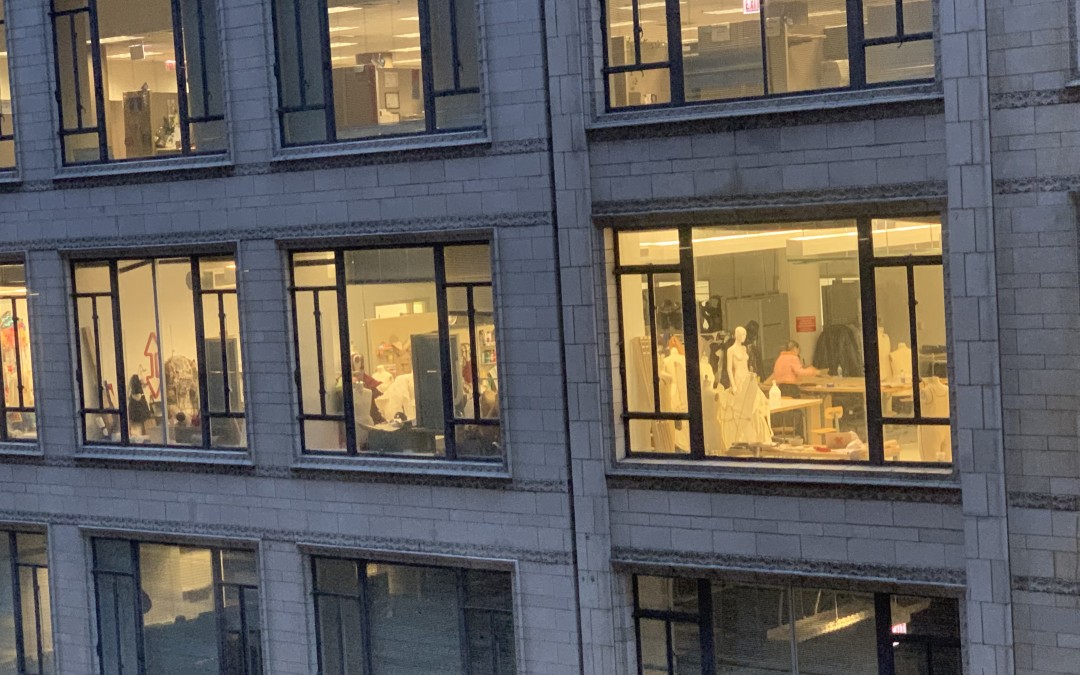The upper floors of the Palmer House in Chicago are so confusing that one sees other guests, rolling bags in tow, get off the elevator and stand puzzled in front of little signs with arrows, then wander haplessly off past portraits of all the famous performers who played its Empire Room in its heyday. Turn left at Judy Garland, bear right at Louis Armstrong, left again at Liberace. If it’s January, the streets below will be cold and gray and cavernous, if less mystifying than the hotel corridors.
In my eighth floor room, I dropped my bags, making a pile of my coat, vest, hat, gloves, and boots. Pulling up the window shades, peering right and left, I glimpsed the L train (for “elevated”) at one end of the block and State Street at the other and then looked directly across the air, at the flat face of a former department store, into something entirely unexpected.
A long row of enormous plate glass windows, and inside, well-lit rooms full of broad doubled worktables, dress forms against all the walls, clothes racks, cabinets. Young intent workers were bent over their close work, cutting fabric, draping, pinning, stitching.
Behind a street level security door, two blank-faced uniforms heard my inquiry but the woman behind the table lit up. “Are you looking at the seventh floor up there? Those are the kids from the Institute.” She smiled. “Aren’t they just something?”
The School of the Art Institute of Chicago has a Fashion Design degree. Fashion is theory, fashion is history, fashion is the future, and in the case of these young artisans, fashion is making.
At the old Guthrie Theater, I used to walk through the costume shop every day, smiling and nodding, not disturbing its air of enclosure, concentration and skill. Opening night was always approaching, and the drapers, stitchers, first hands, and the wonderfully imperial costume director had a lot of work to do. These Chicago workrooms had that same air. A design assignment due, perhaps a runway show? They seemed to be on deadline, and deadlines can be the very anatomy of creativity. As Samuel Johnson said in 1777, in quite another context, “Depend upon it, sir, when a man knows he is to be hanged, it concentrates his mind wonderfully.” The students were concentrating.
On Thursday and Friday of my visit, the rooms were active whenever I looked. On Saturday, they started the day dark. But as I was packing, I looked out and saw a young black man with an upright hairdo flip on the lights directly across, and put an enormous cloud of white tulle on the table. He fluffed the fabric, tossing it into the air and letting it drift. He circled it, regarding. He sat on a nearby table, swinging his legs, looking at it while swigging from a can of something. He approached it and tossed some smaller pieces into the air. He glanced at an empty dress form at the end of the table, then rough-folded one bolt and shook out another length along the big table, watching it. Getting friendly with the fabric.
I turned away and, when I looked back, saw he’d added a portion of something slinky and gold and metallic to the table, and a helping of what might be a cream-colored charmeuse. He held some tulle to the form at the shoulder, figuring out the shape of his intention, before figuring out the structure. Once he had the structure, he would build it all, from nothing but bolts of fabric and an idea.
I couldn’t see the young man’s face, but I could see his hands moving over the material, touching it lightly. Making something from nothing in the old department store room, on a Saturday city morning which, outside, was gray-skied and damp. Alone in a long row of empty workrooms, he was tossing the fabric and letting it settle and seeing something beautiful. Lit up by his idea.
When I left, in a cold rain, the bellman put me in a cab saying “Come back. It’s better in April.” He did not know that up on the seventh floor across the street, the lights were on, tulle was drifting and it was already something very like spring.






































